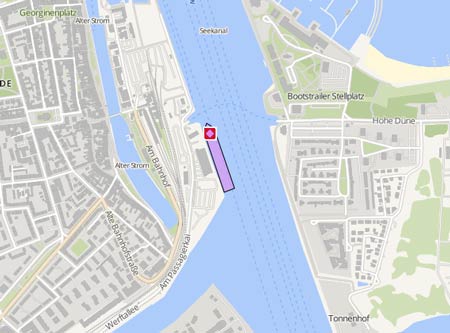IRON CHIEFTAINverschrottet
Kurs/Position
vor 2500 Tagen
Die letzten Häfen
Die letzten Wegpunkte
Die neuesten Nachrichten
ATSB published investigation report into fire
Investigators of the Australian Transport Safety Bureau said the five-day fire on board the 'Iron Chieftain' at the Port of Kembla on June 18, 2018, highlighted the lack of adequate regulatory requirements and standards to address the known risk of fire on-board self-unloading ships. The fire on the vessel started as the ship was discharging a cargo of dolomite. Friction, probably from a failed bearing, generated enough heat to ignite a rubber conveyor belt in the C-Loop internal cargo handling space. A crew member detected a strange smell and white smoke that abruptly changed to black as the crew member approached the deck casing door for the C-loop space. The ship’s crew initiated an emergency response but shipboard efforts to control the fire proved ineffective, spreading to the exterior of the ship to the discharge boom. The ship’s crew were eventually evacuated and Fire and Rescue New South Wales (FRNSW) firefighters took charge of the response. The fire was contained and eventually extinguished about five days later. Although there were no serious injuries or marine pollution as a result of the fire, the fire caused substantial structural damage to the ship including breaches of two fuel oil tanks, and much of the self-unloading system was destroyed. The 'Iron Chieftain' was declared a constructive total loss before it was towed to Turkey for recycling. The incident highlighted the lack of adequate international standards or regulations for dedicated fire detection and fixed fire extinguishing systems in cargo handling spaces of self-unloading bulk carriers. The ATSB’s investigation report also noted that the initial emergency response by the crew, in particular stopping the conveyor belts, which aided the fire’s development as heat could not dissipate. In addition, heat from the fire in the C-Loop space caused thermal stress, cracking and deformation to the adjacent heavy fuel oil tanks, releasing additional fuel for the fire and increasing its intensity and complexity. The absence of international standards for suitable fire detection and fixed fire-extinguishing systems in the cargo handling spaces of self-unloading bulk carriers and the introduction of standards for the fire resistant properties of their conveyor belts has been a contributing factor in at least three major shipboard fires over a 25 year period The ATSB welcomes the commitment by the Australian Maritime Safety Authority (AMSA) and Lloyd’s Register to approach the International Maritime Organization (IMO) and the International Association of Classification Societies (IACS) respectively, to highlight the safety issue regarding the inadequacy of fire safety standards or regulations for self-unloading system spaces. The ATSB was recommending that AMSA formally raise the safety issue with the IMO to initiate safety action aimed at addressing the risk of fire in the cargo handling spaces of self-unloading bulk carriers due to the inadequacy of the current associated standards and regulations. Separately, the investigation noted that while the operators of the 'Iron Chieftain' had identified the fire risk in the ship’s cargo handling space due to the lack of fire detection and fixed extinguishing systems, particularly in the C-Loop space, about five years earlier, the prevention and recovery measures it put in place were not sufficient to mitigate the risk. In response to the fire, the operator’s parent company, the CSL Group, initiated a fire risk mitigation project across its global fleet of self-unloading bulk carriers to improve fire detection and suppression technology, reviewing its firefighting policy and setting minimum fire safety standards for early fire detection and suppression at the ship design and build stage. The ATSB also identified a safety issue relating to Fire and Rescue New South Wales’s marine firefighting capability as well as other safety factors related to the inconsistent conduct of ship’s drills and Port Kembla’s emergency response plans. Full report: https://www.atsb.gov.au/publications/investigation_reports/2018/mair/346-mo-2018-011/
Beached
Beached at Aliaga 18.06.19 https://www.instagram.com/p/By5S-6YHNoV/
Damaged bulkcarrier underway to breakers
The "Iron Chieftain" has left Port Kembla for the last time on March 27, 2019, at 3 p.m. as it began a 100-day journey being towed to Turkey to be scrapped by the Dutch tug "Alp Winger" (IMO: 9367504) with an ETA at Kyme as of June 20. In June 2017 a fire ripped through the tunnels of the ship. It took five days to extinguish the blaze and left the ship beyond repair. Reports with photos: https://www.illawarramercury.com.au/story/5978539/sad-to-see-her-go-iron-chieftain-over-the-horizon-but-not-by-its-own-steam/#slide=4 https://www.abc.net.au/news/2019-03-28/iron-chieftain-farewelled-from-australia/10947934 https://www.illawarramercury.com.au/story/5977132/time-to-say-farewell-as-the-iron-chieftain-leaves-port-kembla/
News schreiben

